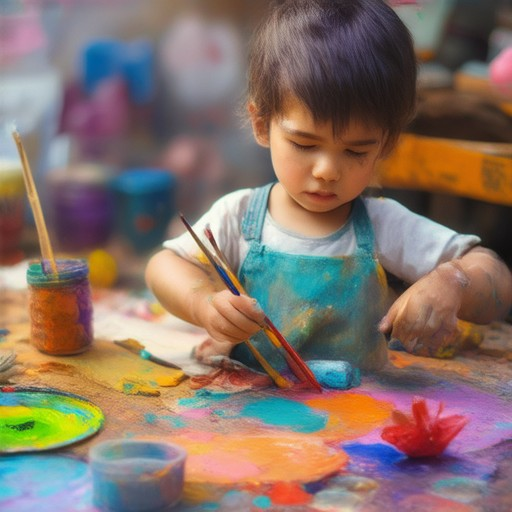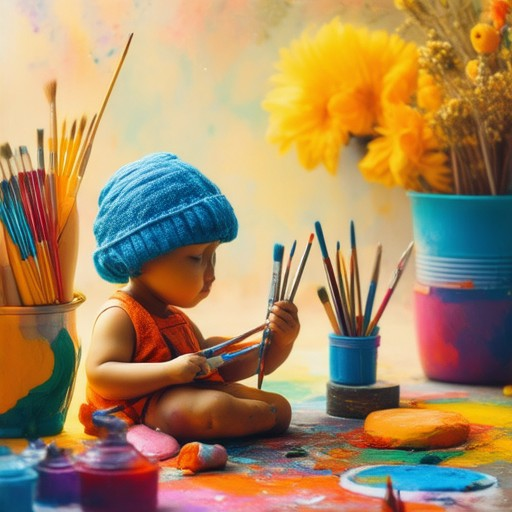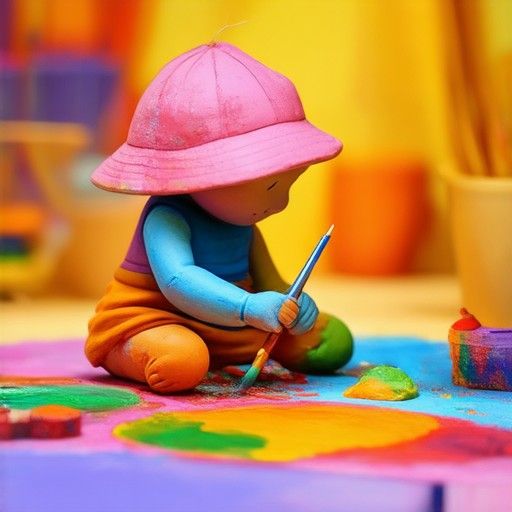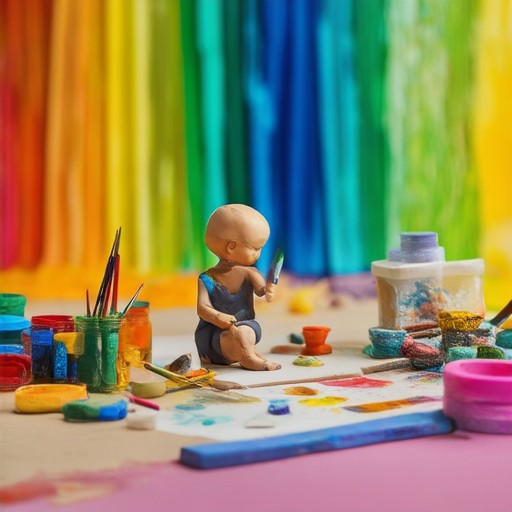Discover a world of creative possibilities with art projects for beginners and kids that are not only fun and easy to execute but also perfect for fostering imagination and learning. Whether you’re looking for simple activities for young children or engaging projects for older kids, these art ideas offer something for everyone, regardless of age or skill level. From quick easy art projects to seasonal themes, these creations provide endless opportunities for creativity and self-expression. Explore the best ways to get started, find inspiration, and organize meaningful art camps for kids, ensuring that every project is both enjoyable and educational. With the right materials and a little guidance, anyone can dive into the wonderful world of art!
Key Takeaways
- Easy Art Projects for Kids: Discover simple, mess-free activities that spark creativity and keep kids engaged.
- Step-by-Step Guidance for Beginners: Learn how to prepare, set up, and teach art to young learners effectively.
- Age-Appropriate Art Ideas: Tailor activities to match your child’s developmental stage for maximum fun and learning.
- Creating a Safe and Creative Environment: Set up a space that encourages exploration without stress.
- Building a Routine for Art: Establish a consistent routine to help kids transition into artistic expression effortlessly.
- Using Music to Enhance Creativity: Calm the mind and boost focus with soothing music during art sessions.
- Teaching Shape Recognition: Introduce basic geometry through fun, interactive shape drawing exercises.
- Inspiring Storytime Art Projects: Transform storytelling into hands-on activities that foster imagination.
- Encouraging Self-Expression: Allow kids to explore their emotions through unrestricted drawing and coloring.
- Embracing Mistakes as Learning Opportunities: Teach kids that creativity thrives in a judgment-free zone.
- Documenting Artistic Growth: Capture milestones and memories with photos or a family art journal.
- Fostering Curiosity and Open-Mindedness: Help kids explore various art mediums and styles to find their unique voice.
- Organizing Successful Art Camps: Plan events that are educational, enjoyable, and inclusive for all ages.

What Are Some Arts and Crafts Ideas for Kids?
Arts and crafts offer a fantastic way for kids to express themselves creatively while having fun. Here are some engaging and educational ideas perfect for children:
- Diy Paper Plate People – Create characters using paper plates, markers, and glue. This activity encourages imaginative storytelling.
- Easy Origami Animals – Teach kids origami with simple animal shapes like elephants and frogs, combining folding with problem-solving skills.
- Handprint Sunflowers – Use finger paints to create sunflower designs, exploring symmetry and color recognition.
- Pizza Box Houses – Transform pizza boxes into miniature houses with paint, glue, and cardboard cutouts, fostering recycling awareness.
- Bottle Cap Art – Turn bottle caps into decorative pieces by painting and arranging them in patterns or frames.
- Tissue Paper Flowers – Create vibrant flowers using tissue paper, wire, and glue, learning about plant structures and colors.
- Sticker Art – Allow kids to arrange stickers on paper to design scenes, encouraging creativity and fine motor skills.
- Foam Plate Paintings – Provide foam plates for kids to paint on, offering a mess-free way to explore colors and shapes.
- Button Bracelets – Help kids learn counting and stringing by making bracelets with buttons of different colors.
- Clay Pottery – Introduce kids to basic pottery techniques, allowing them to design and bake their own ceramic pieces.
- Shaving Cream Sculptures – Use shaving cream to create soft sculptures, teaching about textures and sensory experiences.
- Leaf Rubbings – Explore nature by pressing leaves onto paper, helping kids recognize different leaf shapes and patterns.
- Paper Chain Making – Guide kids in creating chains with paper strips, promoting patience and attention to detail.
- Bean Bag Toss Game – Combine crafting with physical activity by making bean bags and playing a tossing game outdoors.
- Photo Collage – Encourage storytelling through collage-making by gluing photos of family, friends, or favorite things onto paper.
- Rainbow Jar – Create a colorful experiment by filling a jar with water and food coloring to demonstrate chemical reactions.
- Cupcake Liner Puppets – Make puppets using cupcake liners, yarn, and markers, then put on a puppet show for family entertainment.
- Sandcastle Building Kits – Provide materials for building sandcastles, enhancing fine motor skills and imaginative play.
- Alphabet Art – Use paint or markers to create large-scale alphabet letters, turning the space into a mobile art gallery.
- Friendship Bracelets – Teach knotting techniques with friendship bracelet-making, promoting social bonding and dexterity.
- Tin Can Instruments – Recycle tin cans into musical instruments like drums or shakers, introducing kids to rhythm and sound exploration.
- Nature Collage – Encourage kids to collect and arrange natural objects like leaves, branches, and seeds into artistic collages.
- Footprint Art – Capture each child’s unique footprint in paint or clay, creating lasting memories of their growth.
- Yarn Wreath – Create a yarn wreath by wrapping yarn around a circular frame, incorporating buttons or beads for decoration.
- Playdoh Creations – Offer endless possibilities with playdoh, allowing kids to mold, shape, and create whatever their imagination dictates.
- Cardboard Tube Rockets – Build rocket-shaped tubes from cardboard, fostering imaginative play and engineering concepts.
- Button Jewelry – Make jewelry pieces using buttons strung on elastic bands, adding a personal touch to fashion statements.
- Picture Frame Craft – Decorate picture frames with kid-made art, transforming plain frames into meaningful home decor.
- Bottle Cap Wreath – Create a wreath using bottle caps painted and arranged in a circular pattern, recycling materials into art.
- Stained Glass Windows – Design colorful stained glass pieces using plastic sheets and colored cellophane, allowing light to filter through artistic patterns.
- Paper Airplane Contest – Engineer paper airplanes and race them, combining aerodynamics with creative design.
Easiest Art to Make
Creating art can be a rewarding and fulfilling experience, regardless of your skill level. Here are some of the simplest and most accessible art forms to try:
- Watercolor Painting : Known for its vibrant hues and ease of use, watercolor painting is ideal for beginners. It requires minimal tools and can be done on small canvases.
- Acrylic Painting : Fast-drying and versatile, acrylics are perfect for quick projects. They can be applied on canvas, wood, or even glass.
- Digital Art : With tools like Procreate or Adobe Photoshop, you can create stunning digital artwork using your smartphone or computer. Perfect for those who prefer a more modern approach.
- Calligraphy : This meditative art form involves beautiful handwriting. You can practice with markers, pens, or even paintbrushes on paper or canvas.
- Collage Making : Experiment with combining different materials like paper, fabric, or found objects to create unique pieces. It’s a great way to get creative without much preparation.
- Street Art/Murals : While street art can be complex, you can start small by creating your own mini-mural on a small wall or piece of wood.
- Printmaking : Techniques like screen printing or stencil art allow you to create repetitive yet impactful designs. It’s a fun way to explore textures and patterns.
- Mixed Media Art : Combine paints, collage elements, and other materials to create layered, textured pieces. It’s a versatile medium that encourages experimentation.
- Graffiti Art : Learn the basics of spray painting and stenciling to create eye-catching urban art. Just remember to get permission before painting public walls.
- Photomontage : Create collages using existing images, magazine clippings, or scanned photos. It’s a simple way to tell stories or express your creativity.
- Abstract Art : Focus on shapes, colors, and textures rather than specific subject matter. It’s a great way to let your intuition guide your creation.
- Fiber Art : Work with yarn, thread, or fabric to create sculptures, wall hangings, or wearable art. It’s a hands-on process that’s both relaxing and rewarding.
These art forms are perfect for anyone looking to dip their toes into the world of creativity. Whether you’re aiming for a quick project or something more elaborate, there’s something here for everyone!
Want to learn more? Explore our Art Tutorials section for step-by-step guides and inspiration.

Simple Art Ideas for Children
Creating fun and engaging art projects for kids doesn’t have to be complicated. Here are some easy and enjoyable activities that children of all ages can participate in:
- Colorful Dot Paintings : Provide large sheets of paper and washable paints. Let kids drop paint onto paper from a distance to create abstract patterns.
- Sandpaper Sculptures : Offer small figurines or animals made of sandpaper. Kids can carve and shape them into unique creations.
- Sticker Art : Create a scene or pattern using kid-friendly stickers. Encourage imaginative placement and story creation.
- Bottle Cap Art : Collect empty bottle caps and let kids arrange them into patterns or pictures. This eco-friendly project is both fun and educational.
- Paper Plate People : Guide kids in crafting people from paper plates. Add faces, hats, and accessories to bring characters to life.
- DIY Playdough : Make homemade playdough using simple ingredients like flour, water, salt, and food coloring. Kids can mix and mold it into shapes.
- Leaf Rubbings : Take leaves outside and use paper to press them into patterns. Discuss the different shapes and colors observed.
- Button Art : Have kids arrange buttons in patterns or create pictures. This tactile activity enhances fine motor skills.
- Rock Painting : Find smooth rocks and paint them with kid-safe paints. Leave them to dry and display as outdoor art.
These activities require minimal supplies and encourage creativity. Always supervise young children during art projects to ensure safety. For more inspiring ideas, visit our website .

How to Start Art for Kids
Starting art with kids requires preparation, creativity, and a bit of patience. Here’s a step-by-step guide to help you get began:
- Prepare Materials: Gather essential art supplies like crayons, markers, colored pencils, paper, glue sticks, and stencils. Consider age-appropriate tools such as finger paints for younger children.
- Create a Safe Space: Set up a clean, clutter-free area with a sturdy surface like a table. Use a washable tablecloth to protect surfaces from messes.
- Consider Age Appropriateness: Tailor activities to your child’s age. For toddlers, opt for large, chunky toys or finger paints. For preschoolers, introduce scissors and basic shading techniques under supervision.
- Set Up a Routine: Establish a consistent art time, such as after snacks or during free play, to help kids transition into the activity.
- Incorporate Music: Play calming music to create a relaxing environment that encourages creativity and focus.
- Start with Simple Shapes: Use stencils or their own fingers to draw circles, squares, and triangles. Discuss the shapes and their names to enhance learning.
- Move to Coloring Stories: Provide picture books and let kids color scenes based on the stories. Discuss the characters and settings to inspire imaginative thinking.
- Encourage Free Drawing: Place blank paper in front of them and let them express themselves. Offer prompts like “Draw your favorite animal” to guide them if needed.
- Teach Basic Techniques: Demonstrate how to mix colors, blend, and layer. Show them how to use different mediums like watercolors or collage materials.
- Embrace Mistakes: Celebrate errors as part of the creative process. Teach kids that there’s no right or wrong way to create.
- End on a Positive Note: Praise their efforts and creations. Consider giving them a small certificate or displaying their artwork in a family gallery.
- Document Their Progress: Take photos of their artwork or allow them to contribute to a family art journal. This helps track their growth and provides a keepsake.
By following these steps, you’ll help foster creativity, motor skills, and self-expression in children while having fun together!
Where Should a Beginner Start in Art?
Starting in art can be an exciting journey, but it’s essential to approach it methodically. Here’s a guide to help you begin:
- Start with Drawing : Drawing is often recommended as the foundation for any artist. It’s accessible, low-cost, and provides a great way to develop your creativity and technique. Use basic tools like paper and pencils to begin.
- Explore Different Mediums : Once comfortable with drawing, experiment with various art forms. Try painting, sculpture, or digital art to see which medium you enjoy most. Each has its unique challenges and rewards.
- Join a Community : Find local art classes, workshops, or online communities to connect with others who share your passion. Having a supportive network can provide feedback, motivation, and new ideas.
- Document Your Progress : Keep a portfolio of your artwork to track your growth and showcase your achievements. This helps in staying motivated and provides a visual record of your journey.
- Seek Feedback : Share your work with peers or join critique groups to get honest opinions. Constructive criticism can help you identify strengths and areas for improvement.
- Build a Strong Portfolio : As you create, gather pieces that reflect your style and interests. A well-curated portfolio can open doors to opportunities, whether you’re applying for jobs, exhibitions, or further education.
Tips for Success:
– Stay curious and open-minded. Explore different styles and mediums to find your unique voice.
– Be persistent. Artistic growth takes time, so celebrate small victories along the way.
– Enjoy the process. Art should be a source of joy and self-expression, not just a task to complete.
For resources and inspiration, visit Artful Journey , a platform dedicated to supporting artists and art enthusiasts with tutorials, insights, and community connections.

How to Start an Art Camp for Kids
To successfully launch an art camp for kids, follow these organized steps:
- Plan the Location and Timing
- Choose a venue: Consider community centers, parks, or indoor spaces like gyms or church halls.
- Determine the schedule: Opt for weekends or evenings to accommodate family schedules.
- Engage preschoolers, elementary students, and teens with varied interests.
- Contact local schools and community centers for potential participants.
- Use promotional methods: Posters, flyers, and social media announcements in local Facebook groups.
- Prioritize partnerships with schools for effective outreach.
- Offer diverse activities: Age-appropriate art projects, guest artists, workshops, storytimes, and music sessions.
- Incorporate fun elements like drawing races and collaborative art pieces.
- Set session length: 2 hours per week for 6 weeks.
- Request a sign-up deadline to manage attendance numbers.
- Recruit parent helpers or encourage parental participation.
- Collect health forms and conduct background checks for safety.
- Develop a tuition structure covering materials and instructor fees.
- Offer scholarships and seek sponsorships for affordability.
- Implement an easy registration process with online forms and fee waivers.
- Maintain safety standards with background checks and first aid kits.
- Collaborate with local businesses for supplies and space.
- Use social media to showcase progress and gather testimonials.
- Conclude with a closing ceremony to celebrate achievements.
- Collect feedback through surveys for future improvements.




0 Comments